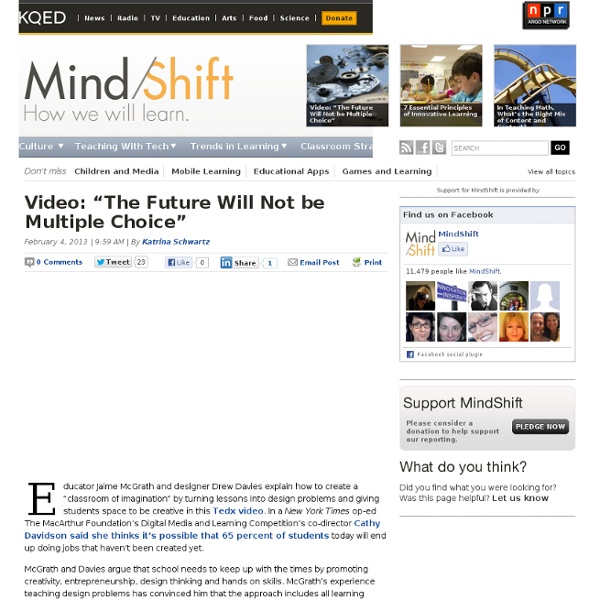Video: “The Future Will Not be Multiple Choice”
Teaching Strategies Educator Jaime McGrath and designer Drew Davies explain how to create a “classroom of imagination” by turning lessons into design problems and giving students space to be creative in this Tedx video. In a New York Times op-ed The MacArthur Foundation’s Digital Media and Learning Competition’s co-director Cathy Davidson said she thinks it’s possible that 65 percent of students today will end up doing jobs that haven’t been created yet. McGrath and Davies argue that school needs to keep up with the times by promoting creativity, entrepreneurship, design thinking and hands on skills. McGrath’s experience teaching design problems has convinced him that the approach includes all learning styles, brings the best of project-based learning, encourages cooperation and integrates subject matter horizontally. Related Explore: design thinking, project-based-learning, TED talk
7 Key Characteristics Of Better Learning Feedback
7 Key Characteristics Of Better Learning Feedback by Grant Wiggins, Authentic Education On May 26, 2015, Grant Wiggins passed away. Whether or not the feedback is just “there” to be grasped or offered by another person, all the examples highlight seven key characteristics of helpful feedback. Helpful feedback is – Goal-referencedTransparentActionableUser-friendlyTimelyOngoingConsistent Though some of these traits have been noted by various researchers [for example, Marzano, Pickering & Pollock (2001) identify some of #3, #5, #1 and #4 in describing feedback as corrective, timely, specific to a criterion], it is only when we clearly distinguish the two meanings of “corrective” (i.e. feedback vs. advice) and use all seven that we get the most robust improvements and sort out Hattie’s puzzle as to why some “feedback” works and other “feedback” doesn’t. 1. Given a desired outcome, feedback is what tells me if I should continue on or change course. 2. 3. Thus, “good job!” 4. 5. 6. 7. References
What should teacher walk-throughs measure?
Teacher walk-throughs are formative data collection opportunities for teachers and leaders to learn about general trends in a school. They are NOT designed to evaluate or judge the performance of a single teacher. This is a common misconception about walk-throughs across our nation. Over the past few weeks, I’ve been closely examining the research on teacher walk-through tools. I even downloaded and read the new book entitled “Engaging Teachers in Classroom Walkthroughs.” Save a few exceptions, the walk-through tools I discovered focused heavily on one set of behaviors: what the teacher is doing. If I’m being honest, when I enter a classroom, I rarely notice what the teacher is doing. When I walk into a classroom, I focus on one thing: the students. I ask myself: What are the students doing? Then, I ask the students: “Why are you doing that?” Over the years, students have provided a variety of answers to the question, ranging from thoughtful to comical to whimsical.
Formative Assessment
A Position of the National Council of Teachers of Mathematics Question: What is the role of formative assessments in mathematics education? Formative assessment is an essential process that supports students in developing the reasoning and sense-making skills that they need to reach specific learning targets and move toward mastery of the mathematical practices set out in the Common Core State Standards. It serves to inform both the teacher and the learner, enabling the teacher to change what he or she is doing and the student to understand where he or she is in relation to the learning goal. In other words, formative assessment provides information that changes what both the teacher and the learner are doing. The United Kingdom Assessment Reform Group has laid out five requirements for assessment to improve learning (Hattie, 2012): Linking assessment to everyday classroom instruction requires teachers to make a shift in both their thinking and their practice. Black, P. Collins, A.
Assessment For Learning: Making Classroom Assessment Work with Anne Davies, Ph.D.
Related:
Related:



